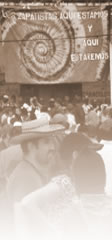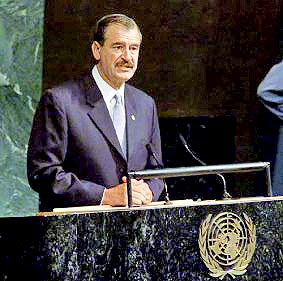
2003
02/01/2004
UPDATE: Mexico-Chiapas, Reports on the Governments
30/09/2004UPDATE II: Zinacantan, Flowers and gazes accompany Zapatistas’ Return
The Facts of the Conflict
Last April 10th, Zapatista supporters from the Highlands of Chiapas suffered an ambush by members of the PRD (Party of the Democratic Revolution) hailing from Zinacantan (Tzotzil municipality from the Highlands, near San Cristobal de Las Casas).
On this day, the Zapatistas were marching to commemorate the death of peasant leader Emiliano Zapata, from whom they took their name and their struggle, for “Land and Freedom.” During the peaceful rally, in an act of solidarity, they also took water to Zapatistas from the community of Jech’vo. This community had been stripped of water service since December 9th , by order of Zinacantan PRD, in an effort to force Zapatista cooperation and participation in the customary cargo system (voluntary service to the community or municipality).
While returning from this act, “Perredistas” (members of the PRD Party) blocked the path, and threw sticks and stones at them. There were some gunshots as well. The outcome: 35 injured and over 500 displaced for fear of being attacked again. This conflict represents some of the worst aggression against Zapatista supporters since the taking up of arms in 1994.
The Good Government Council of Oventik (autonomous Zapatista authorities of the region) issued various communiqués condemning the events, informing about the wounded and giving a list of those responsible for the aggressions. They accused the PRD of “having joined the evil government’s war against the indigenous peoples”.
The national directorate of the PRD expressed that the ambush had to do with a problem surrounding the supply of water and that seeing it as a problem between Perredistas and Zapatistas was incorrect. Likewise, Secretary of Governance, Santiago Creel and Pablo Salazar, Governor of Chiapas, both affirmed that it was “an inter-municipal conflict” over the issue of water.
Return Without Justice
Weeks later, Zapatista authorities announced the return of the displaced families in spite of the fact that those responsible for the assaults still remained at large. On the 25th of December, they petitioned the national and international civil society to organize a caravan to accompany the families’ return and asked that civil peace camps be established in the communities to avoid future aggressions.
200 masked Zapatistas from other highland municipalities joined the caravan as well:
“We’ve come all the way here in order to accompany or brothers and sisters who have found themselves displaced since the 10th of April. But today, we have come to leave our brothers and sisters here, and it is here where they will stay. Because here is their home and here are their people and no one has the right to harass them or run them out of their own community; they are Zapatistas and will continue being so”
(communiqué read by them at the beginning and end of the caravan)
The caravan began on the highway, which is on the way to Tuxtla (capital of Chiapas) and continued all the way to where the displaced were seeking refuge. They remained astonished at the edge of the road, staring at the great number of cars and trucks accompanying the “masked ones”. There were more than 20 vehicles and 100 people, including the national and international civil society, the press and human rights groups. Also providing “accompaniment” were members of the state government, public security forces, Secret Intelligence Center and a helicopter.
The first arrival point was the community of Jech’vo where the tension was palpable. The families that were to stay there got off the trucks and received bouquets of white flowers from the civil society. They got off with their bags and the few belongings that they had taken with them the morning of the attack. Children looked around, frightened and curious, without even slightly understanding the reason behind their ‘stardom’, the reason why dozens of cameras were all over them, robbing them of their anonymity so essential to infancy.
In this first community, Zapatista representatives read a communiqué in the center of the plaza, asking for respect for their life project:
” We want to say again to non-Zapatista brothers and sisters, or to those that belong to other political parties: we the Zapatistas have no wish to fight against our Indigenous brothers and sisters from the same community and the same municipality. We don’t bother anyone, we don’t offend anyone; we the Zapatistas respect everyone without a distinction of organization, party or religion. However, we want respect for ourselves and our fight and resistance. Our fight is not against our poor brothers and sisters; our fight is the cause called democracy, liberty and justice for all.”
They also thanked members of the national and international civil society for their presence. Several international and national observers stayed in order to try and deter possible aggressions. For those returning, this accompaniment by strangers, represents a potential shield, as what they observe and report will be seen by the world.
Meanwhile, dozens of police looked on. In the communities to follow, the tension diminished. In total, 35 families returned to Jech’vo, 19 to Elambo Alto, 33 to Elambo Bajo and 15 to the community of Apaz.
What is at play in this conflict?
Also guiding the caravan was “perredista” municipal president of Zinacantan whom the Zapatistas point to as responsible for instigating aggressions against them. He is from Zinacantan with strong political and economic control in the region. He dominates the truck transportation going daily to Tuxtla. He and his followers were standing all day at the crossroads to Tuxtla from where they observed the caravan going in, coming out and returning to San Cristobal.
The Zapatistas escape his political and economic control. They have their own autonomous authorities and their own political project, which breaks with the official governmental system, but they also have traditional leaders that have dominated these lands for decades.
The conflict in these Zinacanteco communities is not solved. The conditions that exist do not guarantee a return without problems. Zapatistas, however, as well as other indigenous organizations in the state, know the meaning of displacement; not being able to work the milpa (small farm plot), loss of animals and expulsion from their land. No on wanted a new “Polho,” which is the autonomous Zapatista rebel municipality situated in Chenalho (constitutional municipality of the highland region) populated by approximately 5000 displaced peoples as a consequence of the heavy conflict unleashed in that municipality in 1997.
The Highlands are one of the zones where counterinsurgent strategies that have characterized this war “of low intensity” for years were implemented, with the formation of paramilitary groups made up of indigenous people of the same communities but affiliated with the Institutional Revolutionary Party (PRI is the party that controlled the federal, state and municipal powers for over 70 years, up until the year 2000). In Acteal, the escalation of violence ended with the massacre of 45 indigenous people who belonged to the organization Las Abejas, Civil Association on December, 22nd 1997. It’s fitting to mention that the president and vice president of Las Abejas accompanied the return of the Zapatistas in Zinacantan. They know well the pain of years of expulsion and the taste of return without justice.
The events in Zinacantan and Acteal have been compared and caused many to relive the fear and uncertainty that Acteal generated. There are differences. In order to understand the facts of Zinacantan, it is necessary to think about the fact that we find ourselves with a social fabric that has suffered through 10 years of corrosive and total war, characterized by the decomposition and polarization of the communities. Today, conflicts are set off by basic questions like light payments, water, or the construction of roads. But this only represents the spark that could set off the bomb. The essence of the conflict revolves around the inability to respect differences, the issue of power, in the difficulty of allowing the people to determine and decide how to organize their education, government and health or their production.
A return to some single color uniformity is out of the question. Diversity plants a challenge everywhere. Here for the Zapatistas and the rest of the social and political organizations, it represents the seed that must be cultivated in order to allow the white flowers of hope to grow, those that bring back the color of intercultural life.
As of now, those responsible for the aggressions in Zinacantan have not been detained. The tense calm has required that campamentistas remain the Zinacantan communities where the conflict erupted. In those communities, not only is water scarce, but what little there is not clean and is generating stomach and skin diseases and sicknesses.
